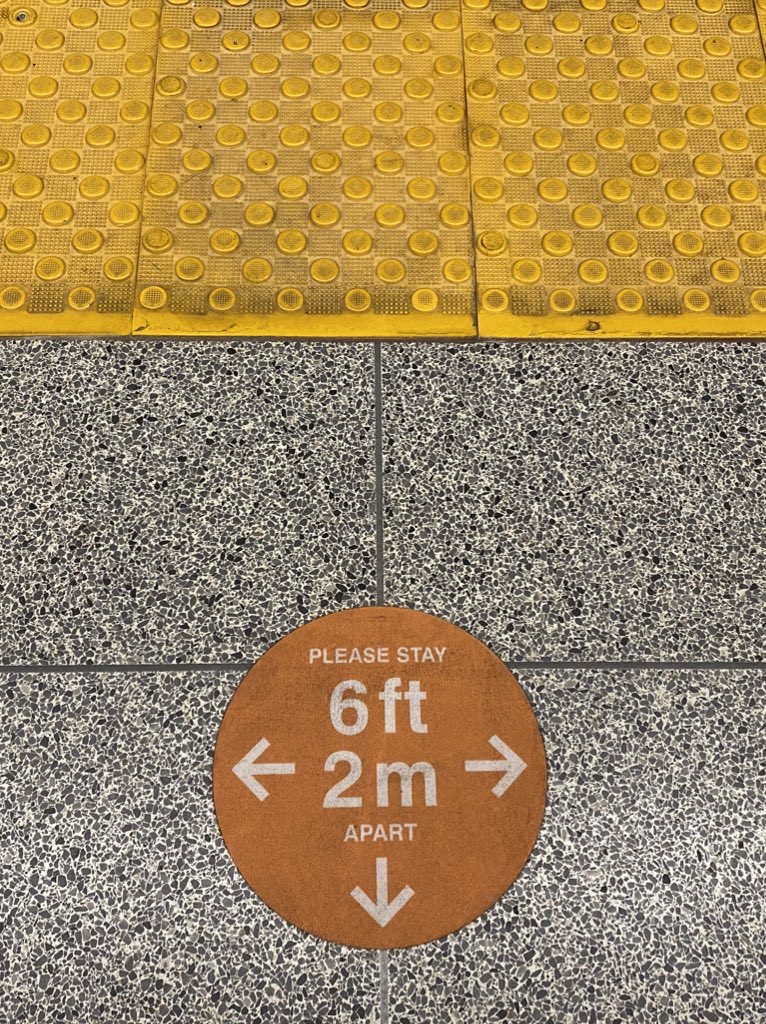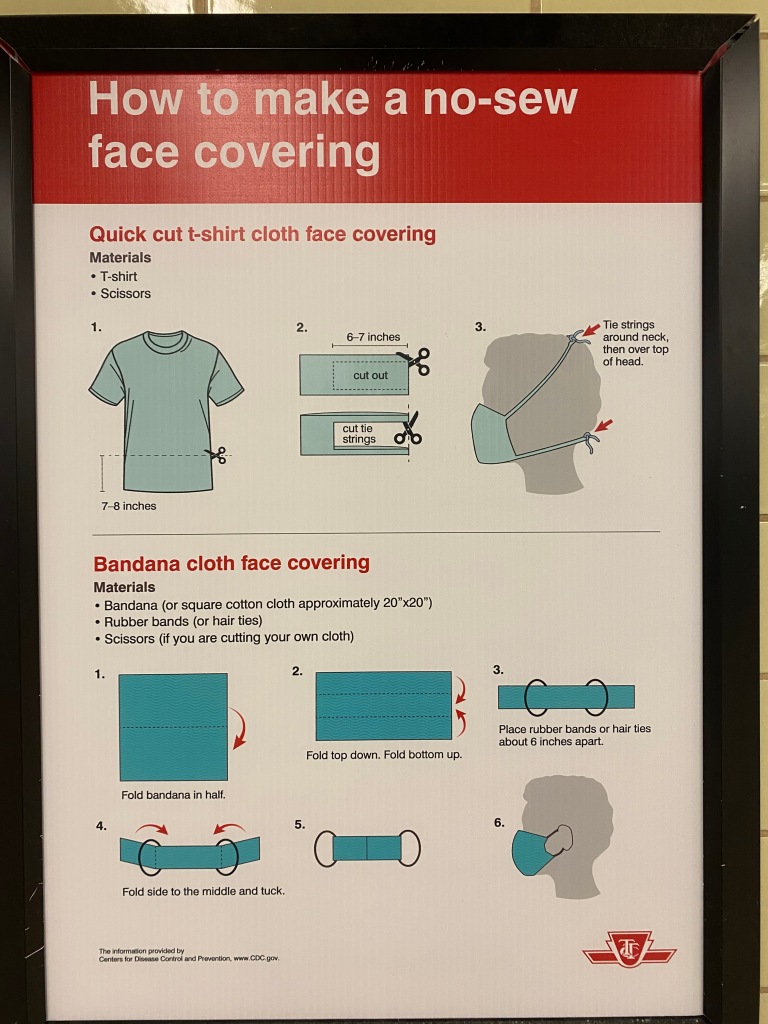
On Thursday, I took the subway for the first time since Ontario declared a state of emergency in March. I entered Queen Station at 9:45 that morning, and rode to Wilson Station. The subway ride north was noticeably quiet, and I had a good choice of seats, even though most were marked as restricted for physical distancing.

On my return home, at 4:00 PM, the subway was busier, but still quiet enough to take a seat in the middle of the train, while just about everyone had a non-restricted seat through the downtown core. That never happened prior to March 13.
As I am used to crowded subway trains — even on Sunday mornings — my first subway rides in months proved to be a surreal experience. Though as most passengers were wearing face coverings and keeping distance, it felt safer and more comfortable than many of my recent supermarket trips.

Though subways are mostly empty, and streetcars pass through downtown with only twenty percent of their normal ridership, things are very different on the buses. In Toronto, Brampton and Mississauga, vehicles regularly bypass crowds of waiting passengers while displaying a “sorry bus full” sign.

Back in March, I mapped the TTC’s most crowded early morning routes. These ten routes were generally located in Toronto’s suburbs, serving employment lands and neighbourhoods with lower incomes and higher proportions of racialized persons. Brampton and Mississauga, which also have large food production and warehousing industries and significant immigrant and racialized populations, are experiencing similar problems with crowding.
All buses only allow passengers to enter through the rear doors, with many seats marked restricted with paper signs similar to those on the subway. The area behind the driver is closed off as well. While the TTC expect riders to tap their Presto cards at the rear or pay by cash or ticket at a subway station, Brampton, Mississauga, and other systems are permitting free rides for now.
A typical TTC bus contains only 33-36 passenger seats; an articulated (“bendy”) bus has 46. The TTC operators’ union instructed its members to allow only 10 customers aboard a standard bus (though the operator has discretion), and 15 aboard an articulated bus. Transporting that few people on each bus is unsustainable, and with tens of thousands of essential workers relying on the TTC to get to work — many of those jobs difficult and poorly-paying — it’s yet another inequity laid bare by this pandemic.

With loosening restrictions, the demand for transit has already begun to increase. By early July, local transit agencies will require all passengers to wear masks or face coverings. At the same time, passengers will be directed to enter buses through the front doors, while reinstating mandatory fare payment.
Meanwhile, Brampton Transit — which was operating on a modified weekend schedule since March — is restoring some of its weekday service on Monday June 15 to meet re-surging demand, while Mississauga increased service levels on June 1. Brampton, Mississauga and Toronto will require masks or face coverings on transit starting July 2.
While Brampton plans to hand out 100,000 free non-medical masks to its transit users, the TTC plans to give out one million disposable masks, specifically targeting lower-income neighbourhoods where transit demand remains high.

Front-door boarding and mandatory mask use will help with some of the capacity issues on buses. Offering free masks is a welcome acknowledgement that many who have taken transit may not have money or time to purchase or make their own face coverings. (The TTC has instructions on how to make rudimentary masks posted in subway stations.)
Even then, bus capacity will continue to be limited to ensure physical distancing, and buses will likely still pass by crowds of waiting customers.
While central Toronto benefits from walkable neighbourhoods, existing and new cycling infrastructure, and subways and streetcars with more capacity to spare, suburban residents will still have to rely on buses. Though I see mandatory mask use as a necessary step towards mitigating the risk of viral transmission, I fear it may not be enough for those who work at hospitals and clinics, food plants and warehouses, and grocery stores, restaurants, nursing homes, and daycares.
Bus riders deserve better.

2 replies on “Sorry, bus full: riding transit during a pandemic”
Looking to the future, it’s a given that the density of passenger loading will be a fraction of what was once considered capacity. I was on a GO bus yesterday where the driver called into operations to ask on capacity permitted. It was a DD bus, and she had 12 persons onboard. The answer (I was sitting in the forward most seat watching my bike on the rack and so able to hear this) was “about 20. There’s no definitive number established by GO at this time” so her load was well within the new limit. I’m surprised that GO hasn’t sectioned off seats as the TTC and others have done.
I ride a full sized conventional bike, a classic rebuilt racer, and I love it. I was out for distance on back country lanes, but the reality of fold-up bikes being the future becomes more apparent with time for regular commuters on transit with spare room due to spacing requirements.
As much as GO presently permit fold-ups during rush-hour (as opposed to regular bikes not) the logic for government agencies to actually promote them rather than just allow them becomes more evident with time. The UK and other nations are presently doing this, to the point of financing and/or granting an amount of money to buy serious quality machines. The logic is that it actually saves money in so many ways directly, and makes for a healthier, happier proletariat.
I couldn’t help but notice towards the end of my ride in Burlington (I’d done Guelph to Hamilton, and just kept going back to Toronto) the number of buses with “Bus Full” on their destination screens. Odd, as we’re not even close to full re-opening. A serious crunch is coming, as any ‘weak link’ in the commute chain is enough to stifle the rest of the commuting network with vast capacity still available.
I note the TorStar running a story on the TTC ‘shutting the subway if too many persons use it’…a recipe for absolute chaos. Best I reference:
https://www.thestar.com/news/gta/2020/06/12/ttc-plans-to-restrict-subway-access-if-crowds-get-to-large-during-covid-19-recovery.html
It’s time….*past time*…for the levels of gov’t to start a program, ostensibly national, to produce a ‘kit’ (as frame material suppliers like Reynolds did in the past, and still do) to supply local builders with a design developed perhaps by the NRC, to build fold-ups for local demand, but able to be serviced nationally due to the nature of their standardized design. Think what the PCC did for streetcars in the Thirties and Forties.
By serendipity, I caught this on YouTube last night:
Not cheap, but for once in my life I’m taking the thought of a fold-up seriously. It would be much safer in poor weather, something very important for our climate, and obviously very optimized for transit use, at all times.
The Crunch is coming. It’s time for transit honchos to start accommodating it as part of the commuting challenge. It will cost a massive amount to institute a national program. It will save even more than it costs. And other nations have already developed the template.
Further to the above: The electric Brompton:
Normally I wouldn’t espouse an electric assist machine, but these aren’t normal times, and thinking must change. For many commuters, these address the times that they just don’t have the oomph to pedal that last ‘missing link’ to work after getting off transit.
The Bromptons are apparently so incredibly well designed, developed and built that I change my stance on Canada developing her own via the NRC or some other agency. The solution would be to licence production, albeit still by a provincial or federal agency.
Even the electric version weighs far less in total than the Toronto Ride-Share behemoths, and will far out-perform them. The aim must be to own or at the most, lease these machines, not rent them like a Ride-Share. The point of their being so easy to compact and carry is to take them everywhere with you.
Again in the above video, the ease of taking them on and off of buses, as well as rail is emphasized. In the prior post, demonstration of their being able to fit into an airplane overhead bin really makes a profound point.